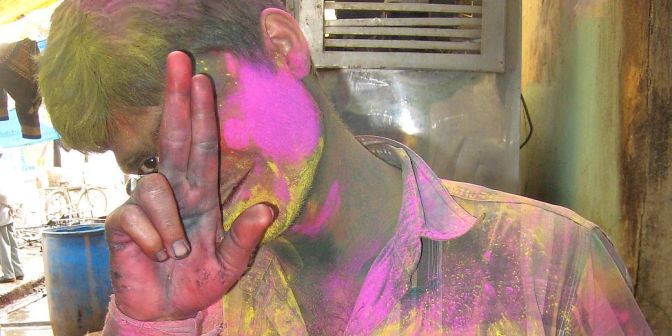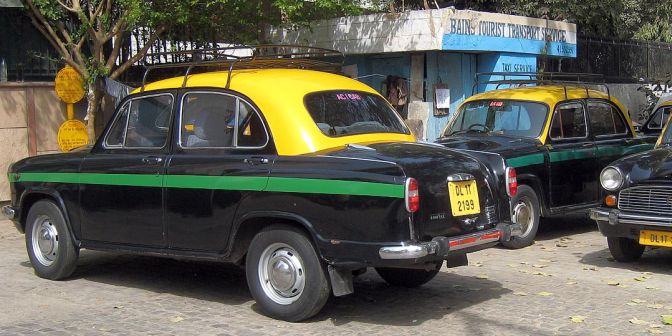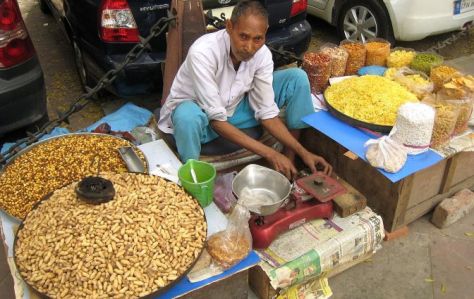I’m bombarded by colourful threats and left red-faced; I’m rejected by Bollywood but star in cricket; I meet a pimp and hot chicks, pink drunks and purple pups.
Today was International Women’s Day. Newspaper articles honoured female Indian leaders and deplored on-going problems. A recent Hindustan Times survey found 91% of Delhi women have experienced sexual harassment, which Indians euphemistically call Eve-teasing. Two thirds of women find public transport unsafe, few have complained to police and nearly three-quarters who do have found them unhelpful.
Today was also Holi, the Indian festival of colours that celebrates the start of spring. Over the last few days street stalls sold vibrant packets of powders and dyes, and all manner of water pistols. Plastic pipe-and-plungers were built like the bamboo rods I saw in an 18th-century painting of Holi. “Machine guns” hold 6 litres of ammunition. Figurines pee spray when pressed. I read of upper-class parties with swimming pools of coloured water.
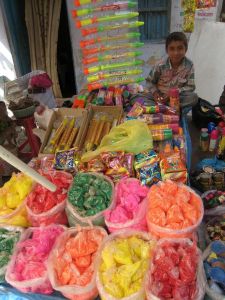 Newspapers exhorted dye-fighters to purchase safe organic colours, not cheaper industrial dyes – made from nice substances like lead, mercury, asbestos or other toxins – that may permanently stain clothing, damage skin, hinder breathing, cause poisoning or even blindness: that charming glitter comes from powdered glass. My SpiceJet magazine showed how to make your own eco-friendly colours from natural substances. Crush black grapes and tomatoes for purple and red, dry and crush Marigold and Jacaranda petals for yellow and blue, mix henna powder with spinach paste for green. It recommended smearing face and hair with coconut oil or petroleum jelly to protect your skin. Papers carried big adverts for washing powder.
Newspapers exhorted dye-fighters to purchase safe organic colours, not cheaper industrial dyes – made from nice substances like lead, mercury, asbestos or other toxins – that may permanently stain clothing, damage skin, hinder breathing, cause poisoning or even blindness: that charming glitter comes from powdered glass. My SpiceJet magazine showed how to make your own eco-friendly colours from natural substances. Crush black grapes and tomatoes for purple and red, dry and crush Marigold and Jacaranda petals for yellow and blue, mix henna powder with spinach paste for green. It recommended smearing face and hair with coconut oil or petroleum jelly to protect your skin. Papers carried big adverts for washing powder.
The Hindustan Times said laws against psychoactive drugs are relaxed at Holi and warned against overdosing on sweets and drinks containing cannabis bhang. It also warned of eye injury from high-speed balloons: don’t try to clean your eye as contaminated water can cause infection, but just shut it tight and rush to the nearest hospital. I visited a Toastmasters club the night before Holi and heard more tales of wild intoxication. One speaker feared the hazardous holiday and planned to stay at home. After all this build-up, I faced the big day with both anticipation and trepidation.
At my hotel breakfast this morning, two enthusiastic American women had already smeared each other and were keen to initiate others. I consented and sallied into the fray with reddened hair, cheeks, beard and shirt. Countless cheerful “happy Holi!” greetings from locals delighted to see a foreigner participating. Now and then a guy gently topped up my smears with red powder, which I’d read was the most safe and wash-outable.
Everything was closed for the public holiday and the metro didn’t run until the afternoon when most of the action is over, so I wasn’t sure what to do. An auto-rickshaw driver offered a lift into town at a dirt cheap rate. As his first customer of the day, he smiled, I’d bring good luck. I’ve heard this line before and, as I suspected, he took me for a ride all the way to his mate’s emporium. I refused to enter and endure high-pressure sales tactics, thanked him for the ride, consulted my compass and headed for Connaught Place. I’d retreated in defeat on my first night (see here) so thought I’d take it back by day.
The circle was almost deserted. Then a man darted across the road in desperation, dodged oncoming cars and leaped into a moving bus. “Cut!” The vehicles reversed a block, and then it all happened again. The film crew waved me away – the fools didn’t want a skinny kiwi in red sunhat to grace their Bollywood blockbuster, although teenage guys take photos with me everywhere I go: I must be a Hindi Facebook sensation!
I joined the assorted spectators, their clothes blotched in assorted colours. Another ear cleaner approached, cotton buds stuck in cap, and flourished a note book of references from satisfied customers. He even had one from NZ. He was eager to investigate my otological condition – “No touch, just looking!” – but I was having none of that.
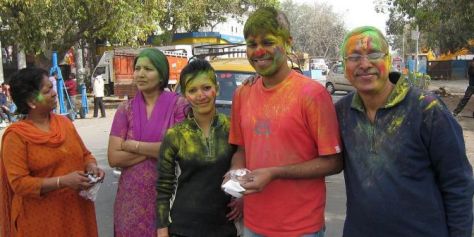 On a corner by my local metro station between drink-vending carts is a tiny mosque you’d almost miss if you blinked. I popped in after the Bollywood action and 8 Muslim boys befriended me. They were 10-13 years old and live here to study the Koran. Good Muslims don’t participate in Holi so they were bored and enjoyed my broken Hindi attempts to chat. Then I was ushered out to the parking lot behind the Metro, given a bat-shaped plank and placed before a concrete slab with stones balanced on top for bails. The lads cheered valiantly when I finally hit the tennis ball before it hit my wicket.
On a corner by my local metro station between drink-vending carts is a tiny mosque you’d almost miss if you blinked. I popped in after the Bollywood action and 8 Muslim boys befriended me. They were 10-13 years old and live here to study the Koran. Good Muslims don’t participate in Holi so they were bored and enjoyed my broken Hindi attempts to chat. Then I was ushered out to the parking lot behind the Metro, given a bat-shaped plank and placed before a concrete slab with stones balanced on top for bails. The lads cheered valiantly when I finally hit the tennis ball before it hit my wicket.
My friendliest Hindi experience yet was followed by the worst. A dozing guy hailed me as I farewelled the lads. After greeting him I clumsily asked, “Do you have boys and girls?” Most people are proud of their offspring. When I asked the rickshaw driver the same question that morning, he had happily enumerated the ages of his kids. This guy’s response seemed to be different. I shook my head in puzzlement and he resorted to a visual aid. Curling one hand into a loose fist, he thrust his other index finger in and out. It dawned on me that he was offering a youngster for less savoury pursuits than cricket.
I played the dumb foreigner – no comprendo – and escaped to the metro, now open, and sped off to another market for the afternoon. One courtyard was lined with cages of live chickens and boiling pots of dead ones. The ground was covered in carcasses, blood, feathers and flies. I was tired and hungry but scenes like this made me unsure what was safe to eat. I found a small general store and bought a pack of digestive biscuits and another of chips. So many of the highs and the lows in India revolve around the stomach and food. Sometimes I eat like a king, with a bottomless delicious platter for three dollars; sometimes I spend the day in a fascinatingly aromatic market where all visible fodder swarms with flies and I’m forced to fast. Perhaps that’s appropriate in Lent.
In the market maze I saw statues of Shiva and Krishna. These gods mostly have blue bodies, which was most fitting for Holi. I was still coloured red and amiable drunks with pink hair and lurid faces shook my hand. Bright splotches on the footpath marked the scene of morning bombardments. The streets were roamed by green and purple dogs.
